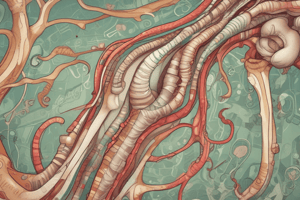Podcast
Questions and Answers
Which of the following are examples of foregut fermenters? (Select all that apply)
Which of the following are examples of foregut fermenters? (Select all that apply)
- Equids
- Pigs (correct)
- Cows (correct)
- Rabbits
Hindgut fermentation is more efficient than rumen fermentation.
Hindgut fermentation is more efficient than rumen fermentation.
False (B)
What is the main site of microbial fermentation in colon fermenters?
What is the main site of microbial fermentation in colon fermenters?
Enlarged colon
Soft feces or cecotropes are composed of cecal contents that are fermented in the __________.
Soft feces or cecotropes are composed of cecal contents that are fermented in the __________.
What are the three groups that livestock can be divided into according to their digestive tracts?
What are the three groups that livestock can be divided into according to their digestive tracts?
What type of animals are often referred to as monogastric and do not rely much on microbial digestion?
What type of animals are often referred to as monogastric and do not rely much on microbial digestion?
Saliva contains ___________ that hydrolyze starch into maltose.
Saliva contains ___________ that hydrolyze starch into maltose.
In monogastric animals, microbial activity mainly occurs in the small intestine.
In monogastric animals, microbial activity mainly occurs in the small intestine.
Match the following food substrates with their respective enzymes and origin in the digestive tract:
Match the following food substrates with their respective enzymes and origin in the digestive tract:
Flashcards are hidden until you start studying
Study Notes
Digestive Tract Physiology
- Digestive systems vary among animals, limiting their ability to utilize certain nutrients
- Digestion involves breaking down large, insoluble molecules into simpler compounds for absorption into the blood and lymph
- Digestion processes involve mechanical, chemical, and microbial activities
Simple Non-Ruminants
- Include animals such as swine, poultry, dogs, cats, rats, and humans
- Often referred to as monogastric animals
- Have a pouch-like, non-compartmentalized stomach
- Rely on chemical digestion of food through secretion of digestive enzymes in the gut, rather than microbial digestion
Functions of Each Major Segment in Simple Non-Ruminants
Oral Cavity
- Physical digestion occurs through mastication of food to increase surface area for exposure to digestive enzymes
- Starch is hydrolyzed to maltose by enzymatic digestion of salivary amylase
Stomach
- Stores ingested feed and meters it into the small intestine
- HCL secreted into the stomach kills most bacteria ingested with feed and hydrolyzes proteins
- In nursing animals, renin is secreted to coagulate casein (a milk protein) to prevent rapid passage of milk out of the stomach
Small Intestines
- Major site of digestion and absorption in simple non-ruminants
- Consists of three segments: duodenum, jejunum, and ileum
- Pancreas serves as a major source of digestive enzymes that break down carbohydrates, proteins, and lipids
- Buffers (bicarbonates) are secreted to neutralize stomach acid
Large Intestines
- A complex ecosystem of anaerobic microorganisms further degrades and metabolizes undigested residues
- Microbial fermentation of carbohydrates produces volatile fatty acids, carbon dioxide, and methane
- Microbial fermentation of proteins and amino acids releases ammonia, which is absorbed via portal blood and converted to urea in the liver
Primary Enzymes of the Digestive Tract
- Amylase: breaks down carbohydrates (starch, glycogen, dextrin) into maltose and glucose
- Maltase: breaks down maltose into glucose
- Lactase: breaks down lactose into glucose and galactose
- Sucrase: breaks down sucrose into glucose and fructose
- Lipase: breaks down lipids into monoglycerides and glycerol
- Pepsin: breaks down proteins into polypeptides
- Trypsin: breaks down proteins into peptides and amino acids
- Chymotrypsin: breaks down proteins into peptides and amino acids
- Carboxypeptidase: breaks down proteins into peptides and amino acids
- Aminopeptidase: breaks down peptides into amino acids
- Dipeptidase: breaks down peptides into amino acids
- Nucleotidase: breaks down nucleotides into nucleosides and phosphoric acid
- Nucleosidase: breaks down nucleosides into purines and phosphoric acid
Ruminants
- Differ from simple non-ruminants in having a large, compartmentalized stomach
- Microbes that inhabit the large stomach accomplish most of the digestion
- Functions of each segment:
- Mouth and teeth: adapted for grinding and grasping fibrous feeds
- Stomach: consists of rumen, reticulum, omasum, and abomasum
- Rumen: a fermentation vat where microbes ferment ingested feeds
- Reticulum: traps foreign materials, regulates flow of ingested feeds
- Omasum: regulates flow of ingested feeds, promotes maximum fermentation efficiency
- Abomasum: site of secretion of gastric juices and proteolytic enzymes
Non-Ruminant Herbivores
- Include animals such as horses, rabbits, guinea pigs, zebras, elephants, and hippopotamuses
- Intermediate between simple non-ruminants and ruminants in their digestive physiology and nutrition requirements
- Can be further subdivided into foregut fermenters, colon fermenters, and cecal fermenters
Foregut Fermenters
- No important domesticated species
Colon Fermenters
- Examples include equids
- Enlarged colon is the site of microbial fermentation of materials that resist breakdown in the small intestine
- High-quality proteins, starch, and lipid are digested in the small intestine
- Fiber digestion is less efficient, and the animal inefficiently utilizes bacterial proteins from digestion/metabolism of microbes
Cecal Fermenters
- Examples include rabbits
- Have low digestibility of fiber, so they adapt by selectively separating and excreting indigestible fiber and retaining the more digestible non-fiber contents for fermentation in the cecum
- Produce two types of feces: hard and soft
- Soft feces, or cecotropes, are actually cecal contents that are fermented in the cecum and utilized by the animal for nutritional value in a process called coprophagy
Studying That Suits You
Use AI to generate personalized quizzes and flashcards to suit your learning preferences.




